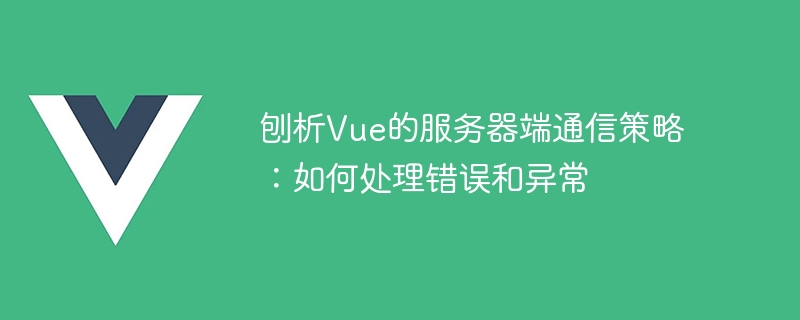Home >Web Front-end >Vue.js >Analyzing Vue's server-side communication strategy: how to handle errors and exceptions
Analyzing Vue's server-side communication strategy: how to handle errors and exceptions
- WBOYWBOYWBOYWBOYWBOYWBOYWBOYWBOYWBOYWBOYWBOYWBOYWBOriginal
- 2023-08-11 09:12:231357browse

Analysis of Vue’s server-side communication strategy: how to handle errors and exceptions
When developing web applications, communicating with the server is essential Task. As a popular front-end framework, Vue.js provides a powerful set of tools and methods to handle communication with the server. In this article, we will focus on Vue’s server-side communication strategies and focus on how to effectively utilize these strategies when handling errors and exceptions.
In Vue, we usually use axios to handle server-side communication. Axios is a Promise-based HTTP client available in the browser and Node.js. It has many useful features such as intercepting requests and responses, converting request and response data, etc.
First, let's look at a simple example. Assuming we have an API that gets a list of users, we can use axios to send an HTTP GET request to get the data. The following is a sample code using axios:
import axios from 'axios';
axios.get('/api/users')
.then(response => {
// 处理成功响应的数据
console.log(response.data);
})
.catch(error => {
// 处理错误
console.error(error);
}); In the above code, we use axios to send a GET request to /api/users and print the return after the successful response The data. If an error occurs, we will output the error message to the console.
However, this is not a best practice for handling errors and exceptions. In most cases, we want to be able to handle errors and exceptions based on the status code of the response. For example, if the server returns a 404 status code, indicating that the requested resource cannot be found, we may want to display an error message to the user.
In order to better handle errors and exceptions, we can use the interceptor function of axios. Interceptors allow us to intercept and process requests or responses before sending them. The following is a sample code that uses axios interceptors to handle errors and exceptions:
import axios from 'axios';
// 请求拦截器
axios.interceptors.request.use(
config => {
// 在发送请求之前做些什么
return config;
},
error => {
// 处理请求错误
return Promise.reject(error);
}
);
// 响应拦截器
axios.interceptors.response.use(
response => {
// 对响应数据做点什么
return response;
},
error => {
// 处理响应错误和异常
if (error.response) {
// 处理响应错误
console.error(error.response.data);
} else if (error.request) {
// 处理没有响应的请求
console.error(error.request);
} else {
// 处理其他异常
console.error(error.message);
}
return Promise.reject(error);
}
);
// 发送请求
axios.get('/api/users')
.then(response => {
// 处理成功响应的数据
console.log(response.data);
});In the above code, we define a request interceptor and a response interceptor. Request interceptors are used to process request data before sending the request, while response interceptors are used to process response data after the response is received.
You can perform some common processing in the request interceptor, such as adding authorization headers. In the response interceptor, we first check if the response exists. If it exists, it means that the server has returned, we can check the response status code and handle the error according to the situation. If there is no response, we may need to handle some unresponsive requests or other exceptions.
In addition to using interceptors to handle errors and exceptions, we can also handle errors and exceptions through the catch method of Promise. For example:
axios.get('/api/users')
.then(response => {
// 处理成功响应的数据
console.log(response.data);
})
.catch(error => {
// 处理错误和异常
console.error(error);
});In the above code, we handle errors and exceptions by using the catch method in the Promise chain. If an error occurs in any .then callback function in the chain, it will jump to the nearest .catch callback function for processing.
To summarize, we explored Vue’s server-side communication strategy in this article, focusing on how to handle errors and exceptions. We learned how to use axios to send requests and handle data for successful responses, and how to use interceptors and Promise's catch method to handle errors and exceptions. I hope this article will help you understand and apply Vue's server-side communication strategy!
The above is the detailed content of Analyzing Vue's server-side communication strategy: how to handle errors and exceptions. For more information, please follow other related articles on the PHP Chinese website!
Related articles
See more- About vue using validator: VeeValidate3
- What are the differences between computed and method in Vue?
- Introduction to the method of turning off Eslint verification in the vue project
- Introduction to several methods of defining component templates in Vue.js
- Four places to implement AJAX in Vue applications

